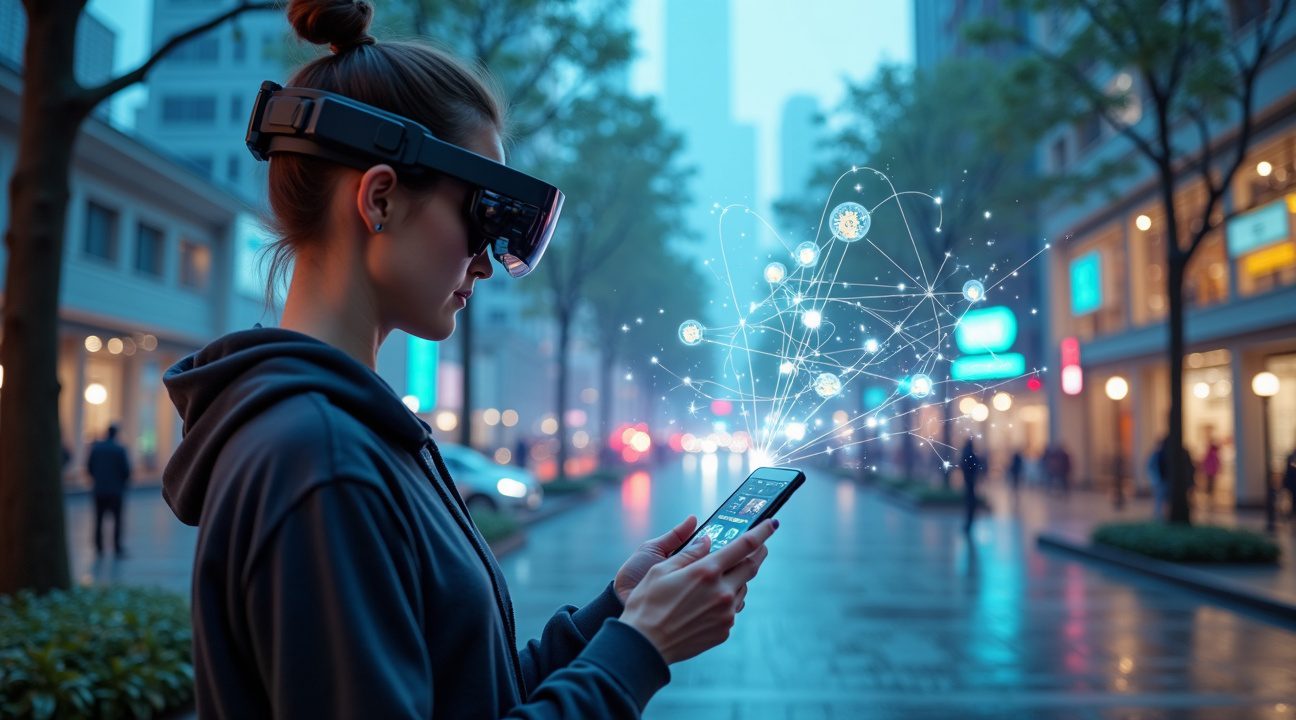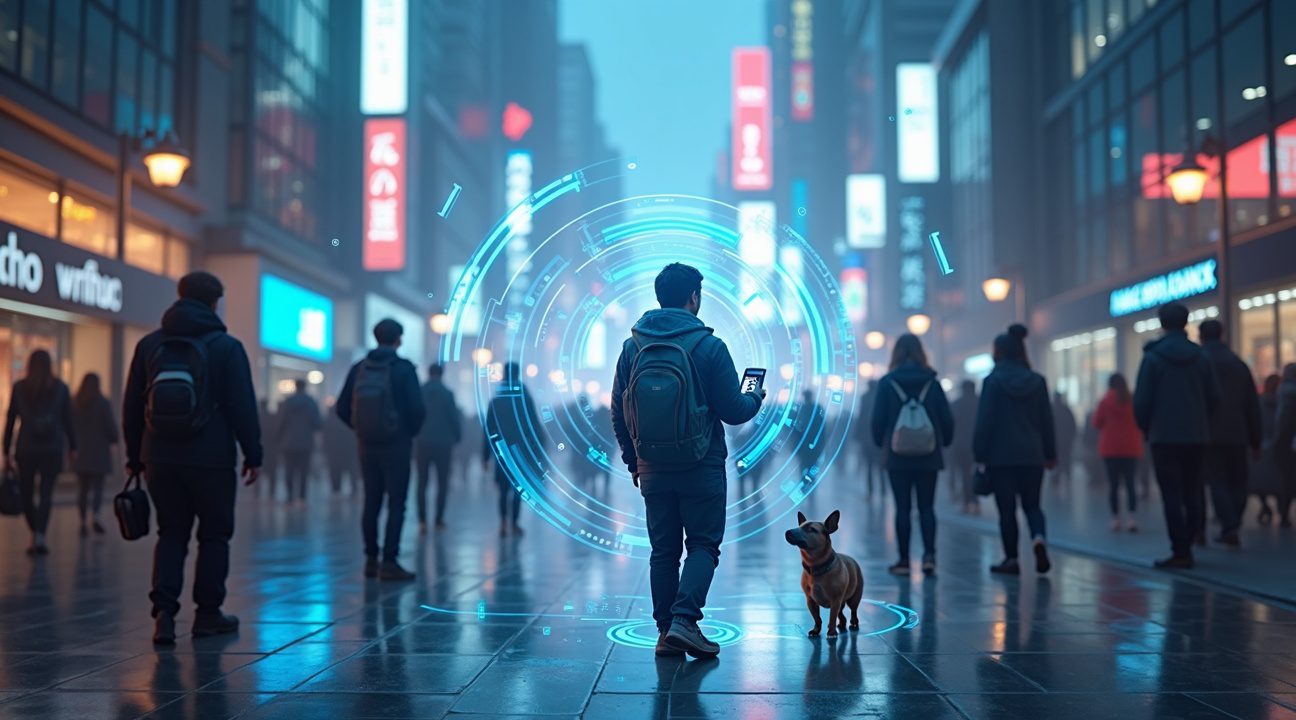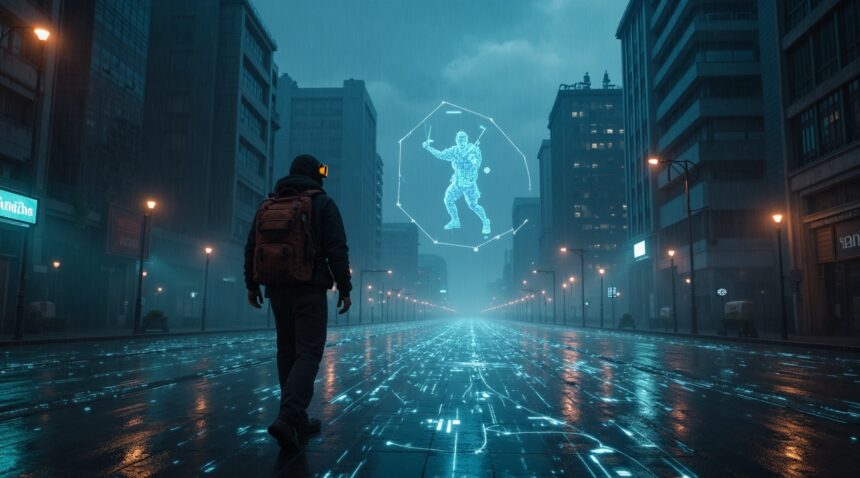Hideo Kojima has unveiled an innovative collaboration with Niantic Spatial—renowned for creating Pokémon GO—to launch an augmented reality project inspired by his hit game, Death Stranding.
Key Takeaways
- Revolutionary AR Technology: The project integrates AR glasses and smartphones to layer digital objects on real-world environments, allowing players to interact with virtual artifacts that are physically anchored in their surroundings.
- Narrative-Driven Experience: Departing from the collection-style gameplay of Pokémon GO, this new endeavor places storytelling at the forefront. It focuses on exploring “invisible stories between people,” turning common public and private spaces into interactive storytelling environments.
- Proven Commercial Foundation: The initiative is grounded in strong commercial success, leveraging Pokémon GO’s lifetime earnings exceeding $6 billion and the over 5 million units sold of Death Stranding to signal widespread interest in immersive AR gaming.
- Advanced Environmental Interaction: Utilizing Niantic’s cutting-edge geospatial AI, the experience can recognize and respond to physical elements such as benches, walls, or staircases, bridging the digital and physical worlds more seamlessly than ever before.
- Social Connectivity Focus: Players won’t just consume a narrative—they’ll shape it with others. Emphasis is placed on community-driven storytelling, allowing users to leave behind traceable, interactive narratives in shared spaces for others to discover.
Further Exploration
For more details on Niantic’s platform and previous successes, visit the official Niantic Labs website. To learn more about Hideo Kojima’s past works and his studio’s creative philosophy, check out Kojima Productions online.
Death Stranding Creator Teams Up with Pokemon GO Developers for Revolutionary AR Experience
Hideo Kojima has officially announced an exciting new collaboration with Niantic Spatial, the development team responsible for Pokemon GO’s massive success. I find this partnership fascinating because it combines Kojima’s innovative storytelling approach with Niantic’s proven expertise in location-based gaming technology.
The announcement came during the “Beyond the Strand” 10th-anniversary event for Kojima Productions, where the legendary game designer revealed plans for what he describes as “like the real Death Stranding in the real world.” This description immediately signals that players will experience real-world movement and exploration as core gameplay mechanics, much like they do in mobile gaming experiences.
Bridging Virtual and Physical Worlds
The collaboration represents a significant shift in how interactive entertainment can blend with everyday life. Niantic Spatial brings cutting-edge geospatial AI technology to the table, which has already proven successful in creating engaging location-based experiences. Their expertise in augmented reality gaming provides the technical foundation for Kojima’s ambitious vision of real-world exploration.
This partnership promises several innovative features that could redefine walking simulators:
- Real-world environmental interaction through advanced AR technology
- Social connectivity features that encourage player cooperation across physical distances
- Dynamic storytelling that adapts to actual geographic locations and weather conditions
- Integration of Kojima’s signature narrative depth with location-based gameplay mechanics
Kojima Productions has always pushed boundaries in interactive storytelling, and this project appears to continue that tradition. The collaboration suggests a game that won’t just simulate walking but will actually require physical movement to progress, creating a unique blend of exercise and entertainment.
The timing of this announcement feels particularly strategic, given the growing interest in immersive entertainment experiences across different media platforms. Players can expect the same attention to detail and philosophical depth that characterizes Kojima’s previous work, now enhanced by Niantic’s proven ability to create compelling real-world gaming experiences.
Early details suggest the project will leverage advanced augmented reality features to create meaningful connections between players and their physical environment. The emphasis on “real-world exploration” indicates that geographic diversity will play a crucial role in gameplay, potentially making each player’s experience unique based on their actual location.
This collaboration also represents a significant evolution in the walking simulator genre. Traditional walking simulators focus on narrative exploration within virtual environments, but this project promises to transform actual walking into a core gameplay mechanic. The integration of Niantic’s geospatial AI technology could create dynamic, location-aware storytelling that responds to real-world conditions.
The partnership between Kojima Productions and Niantic Spatial could influence how other developers approach future gaming projects, particularly those seeking to blend physical activity with digital entertainment. The success of Pokemon GO has already demonstrated the massive appeal of location-based gaming, and Kojima’s involvement suggests even more sophisticated possibilities for the medium.
Industry observers note that this collaboration could establish new standards for augmented reality gaming experiences. The combination of Kojima’s creative vision with Niantic’s technical expertise in location-based gaming creates opportunities for unprecedented innovation in interactive entertainment.
The project’s emphasis on real-world connection and movement aligns with growing trends in health-conscious gaming and community building through shared experiences. Players will likely find themselves part of a larger network of individuals exploring their physical environments while participating in Kojima’s distinctive narrative style.
https://www.youtube.com/watch?v=H-0hvj0q218
AR Glasses and Smartphone Technology Bring Digital Objects to Life
I observed how the initial teaser revealed a fascinating glimpse into this ambitious project’s technical foundation. The demonstration showed a player seamlessly using AR glasses alongside a smartphone to interact with digital objects overlaid onto real-world environments. This combination hints at mixed reality experiences that go far beyond traditional mobile gaming, creating an immersive layer where virtual elements become tangible through advanced augmented reality.
Advanced Object Recognition Creates Interactive Environments
Niantic Spatial’s platform serves as the technological backbone, offering sophisticated capabilities to scan and recognize real-world objects and environments. This system transforms everyday locations into interactive spaces through AR technology. Unlike simple location-based features found in traditional gaming apps, this platform can identify specific objects, surfaces, and architectural elements, making them responsive to player interaction.
The project’s trailer depicted virtual “artifacts” and glowing lines connecting different real-world locations across various environments. These visual elements suggest a networked gameplay component that encourages cooperation and exploration between players. I noticed how these connections create a sense of shared discovery, where players can leave digital traces for others to find and interact with in physical spaces.
Integrated Technology Stack Enables Deep Environmental Engagement
The technology setup represents a significant leap forward in AR gaming architecture. Players utilize AR glasses for immersive augmented visuals that overlay digital content directly onto their field of vision. The smartphone functions as the primary interface, handling input commands, data processing, and connectivity features. Niantic’s AI system powers the object and environment recognition capabilities, allowing the game to understand and respond to real-world contexts.
This level of integration distinguishes the project from earlier AR games by enabling deeper environmental engagement. Previous AR experiences often relied on simple GPS coordinates or basic image recognition. However, this new approach can identify specific textures, shapes, and spatial relationships within environments. Players can interact with park benches, building facades, or natural landmarks as if they were game elements.
I find the potential for persistent digital overlays particularly compelling. The technology appears capable of anchoring virtual objects to specific physical locations, creating a shared augmented space that multiple players can access over time. This persistence transforms ordinary locations into dynamic game environments where actions have lasting consequences.
The smartphone component handles complex calculations and network communications while the AR glasses provide hands-free visual feedback. This division of labor allows for extended gameplay sessions without the fatigue typically associated with holding devices for extended periods. The system can recognize when players approach previously marked locations or objects, triggering contextual interactions and story elements.
Environmental scanning capabilities enable the game to adapt to different settings automatically. Whether players explore urban environments, natural landscapes, or indoor spaces, the AI can identify appropriate surfaces and objects for interaction. This adaptability ensures consistent gameplay experiences regardless of location, making the walking simulator concept truly universal.
The networking component creates opportunities for asynchronous multiplayer experiences. Players can discover traces left by others, solve collaborative puzzles, or contribute to shared objectives that persist across multiple sessions. This social layer adds depth to the solo exploration experience while maintaining the contemplative nature that defines Kojima’s work.
Advanced motion tracking through the smartphone’s sensors allows for precise interaction with virtual objects. Players can reach out to touch, move, or manipulate digital artifacts as if they existed in physical space. The AR glasses provide visual feedback that makes these interactions feel natural and intuitive, bridging the gap between digital and physical interaction paradigms.
https://www.youtube.com/watch?v=Hrf4oLGMNE8

Transforming Everyday Life Into Interactive Storytelling
Kojima’s ambitious vision extends far beyond traditional gaming boundaries, aiming to transform everyday life into art and entertainment through augmented reality technology. His collaboration with Niantic represents a fundamental shift in how interactive narratives can unfold within physical spaces, using AR as a canvas for exploring connection, perception, and what he describes as “invisible stories between people.”
Unlike conventional gaming experiences, this project positions storytelling as the core driving force rather than an afterthought or supplementary element. John Hanke, CEO of Niantic, emphasized that the game is built to “bring people together to play” through narrative, marking a significant departure from their previous approach with Pokémon GO, where story elements remain largely absent.
Narrative-Driven AR Experience
The contrast between this new project and Pokémon GO couldn’t be more striking. While Pokémon GO succeeded through location-based mechanics and collection gameplay, Kojima’s collaboration will center on story and world-building as primary features. This approach leverages Kojima’s extensive history of layered, cinematic involvement in game development, creating an experience that seamlessly blends cinematic narrative techniques with real-world AR technology.
The project draws on Kojima’s renowned expertise in crafting complex, interconnected stories that unfold through multiple layers of meaning. His previous works demonstrate an understanding of how environmental storytelling and player agency can create powerful emotional connections. By applying these principles to augmented reality, the team aims to create narratives that exist within and respond to players’ actual surroundings.
Players will encounter stories that emerge organically from their daily routines and environments. The technology recognizes that every street corner, park bench, or coffee shop holds potential for narrative discovery. Rather than imposing artificial game mechanics onto real locations, the experience will reveal hidden connections and stories that feel authentic to each specific place.
The storytelling approach emphasizes human connection through shared experiences. Multiple players occupying the same physical space will contribute to evolving narratives, creating collaborative storytelling opportunities that extend beyond individual gameplay sessions. This social element transforms solitary walks into potential chapters of larger, community-driven stories.
Kojima’s cinematic background influences how these stories will unfold visually and emotionally. Players can expect carefully crafted visual compositions that frame familiar environments in new ways, encouraging them to see their surroundings through different perspectives. The AR technology serves as a storytelling medium that reveals layers of meaning previously invisible in everyday spaces.
The project represents a significant evolution in how developers approach location-based entertainment. Instead of simply overlaying digital elements onto physical spaces, the team focuses on discovering and amplifying stories that already exist within those environments. This philosophy suggests that every neighborhood, building, and pathway contains narrative potential waiting to be discovered and shared.
By prioritizing narrative depth over mechanical complexity, the collaboration promises to create meaningful experiences that resonate long after players finish their sessions. The focus on invisible connections between people suggests that stories will emerge from collective human experiences rather than predetermined quest structures.
This approach to interactive storytelling could influence how other developers think about gaming applications and their relationship to physical spaces. The emphasis on story-driven AR experiences may inspire new categories of entertainment that blend digital narrative with real-world exploration in unprecedented ways.
High-Profile Partnership Signals New Era for AR Gaming
The gaming industry rarely witnesses collaborations that carry such transformative potential as the partnership between Kojima Productions and Niantic Spatial. This union brings together one of gaming’s most celebrated auteurs with the company that revolutionized mobile AR gaming, creating unprecedented possibilities for immersive entertainment.
Hideo Kojima’s studio, renowned for groundbreaking titles like Death Stranding and Metal Gear Solid, brings decades of innovative storytelling and experimental game design to this collaboration. Meanwhile, Niantic Spatial represents the cutting-edge evolution of the company behind Pokemon GO, which achieved over 1 billion downloads globally and proved that AR gaming could capture mainstream audiences on an extraordinary scale.
Strategic Convergence of Creative Vision and Technical Innovation
Niantic Spatial operates as a newly branded division specifically focused on geospatial AI technology, positioning this partnership at the forefront of spatial computing advancement. The collaboration leverages Niantic’s proven track record with successful AR titles including:
- Pikmin Bloom
- Monster Hunter Now
- Ingress Prime
Each of these titles demonstrates different approaches to location-based gaming experiences.
Both companies describe their joint project as an attempt at “redefining immersive entertainment”, suggesting ambitions that extend far beyond traditional gaming boundaries. This gaming industry collaboration represents a significant shift where established game creators embrace emerging technologies to create entirely new entertainment categories.
The partnership’s timing reflects broader industry trends where traditional game developers recognize the untapped potential of AR technology. Pokemon GO’s massive success established the commercial viability of location-based gaming, while Kojima’s reputation for pushing creative boundaries suggests this project will explore uncharted territory in interactive entertainment.
Kojima’s expertise in crafting emotionally resonant narratives combined with Niantic’s geospatial AI capabilities creates unique opportunities for storytelling that responds to real-world environments. This technological foundation enables experiences where physical locations become integral narrative elements, transforming everyday spaces into interactive story components.
The collaboration signals a broader evolution in how major gaming figures approach mobile and AR platforms. Rather than treating these technologies as secondary platforms, industry leaders increasingly view them as primary venues for innovation. This partnership validates AR gaming’s maturation from novelty to legitimate creative medium capable of supporting complex, ambitious projects.
Beyond Pokemon GO’s Success: Revenue and Market Potential
The foundation for this ambitious collaboration rests on proven commercial success from both creators. Pokemon GO has generated more than $6 billion in lifetime revenue since its launch, establishing Niantic as the undisputed leader in AR walking games. This massive financial achievement demonstrates the market’s appetite for location-based gaming experiences that blend digital content with physical movement.
Proven Track Records in Gaming Innovation
Kojima’s track record speaks volumes about his ability to create commercially viable experimental games. Death Stranding had sold over 5 million copies by mid-2021, proving that players will embrace unconventional gameplay mechanics when they’re backed by compelling narratives and innovative design. This success shows that Kojima’s vision for walking-focused gameplay resonates strongly with audiences, making him an ideal partner for Niantic’s AR expertise.
The convergence of these two powerhouses suggests enormous market potential for their upcoming project. While entertainment industries continue expanding into new mediums, the gaming sector particularly benefits from innovations that merge physical activity with digital engagement.
Market Dynamics and Future Projections
Current market conditions favor AR walking games more than ever before. The success of Pokemon GO helped bring AR walking games to mainstream attention, creating a ready audience for similar experiences. Health-conscious consumers increasingly seek entertainment options that encourage physical activity, positioning this collaboration at the intersection of multiple growing trends.
However, concrete details about the new project remain scarce. As of September 2025, no release date or final title for the new AR project has been announced, leaving industry analysts to speculate about its potential impact. Details about the new game’s planned reach or technical specifications remain largely under wraps, with no concrete statistics shared yet about expected user bases or revenue projections.
The gaming industry has shown remarkable growth in AR applications, with successful titles like various gaming platforms demonstrating consumer willingness to adopt new technologies. Investment patterns suggest that major studios recognize AR’s potential, particularly when combined with established franchises or innovative storytelling approaches.
Consumer spending habits indicate strong potential for premium AR experiences. Players have demonstrated willingness to invest in games that offer unique experiences, whether through direct purchases or in-app transactions. The combination of Kojima’s narrative expertise and Niantic’s technical prowess could create a product that commands premium pricing while maintaining broad appeal.
The timing appears strategic, as AR technology has matured significantly since Pokemon GO’s initial release. Modern smartphones offer improved processing power, better cameras, and more sophisticated sensors, enabling more complex AR interactions than previously possible. This technological advancement creates opportunities for richer gameplay experiences that could justify higher price points and longer player engagement periods.
Geographic expansion represents another significant opportunity. While Pokemon GO achieved global success, certain markets remain underexplored for AR walking games. A Kojima-designed experience could appeal to different demographic segments, potentially opening new revenue streams in regions where his storytelling style resonates particularly well.
The collaboration also benefits from reduced market education requirements. Unlike Pokemon GO’s launch period, when consumers needed introduction to AR gaming concepts, today’s market includes millions of players already familiar with location-based gameplay mechanics. This established user base could accelerate adoption rates and reduce marketing costs associated with explaining basic concepts.
Industry partnerships and licensing opportunities present additional revenue potential. Kojima’s reputation for creating culturally significant games could attract brand collaborations, merchandising deals, and cross-media adaptations that extend far beyond initial game sales. These secondary revenue streams often prove crucial for maximizing returns on ambitious development projects.
The success metrics from both creators suggest that their collaboration could achieve exceptional financial performance while pushing creative boundaries. Their combined expertise positions this project to capture both mainstream audiences seeking accessible AR experiences and dedicated fans eager for innovative gameplay concepts.

Sources:
TechRadar, “Kojima Productions is teaming up with Pokemon GO creator Niantic for a new AR project”
TheGamer, “Hideo Kojima Is Working With The Creators Of Pokemon Go On A Real-Life Walking Simulator”
WorthPlaying, “Kojima Productions Partners With Pokemon Go Developer Niantic Spatial For New Real-World Project”
TechJuice.pk, “Hideo Kojima & Niantic Get Together to Launch New AR Project”
Beebom, “Hideo Kojima Teams up with Pokemon Go Dev Niantic for a next Level AR Project”


